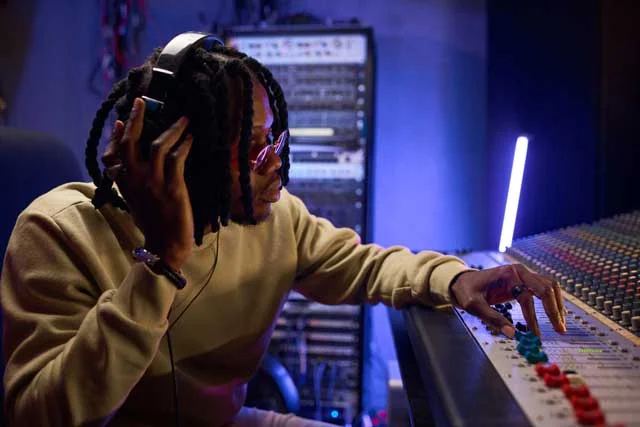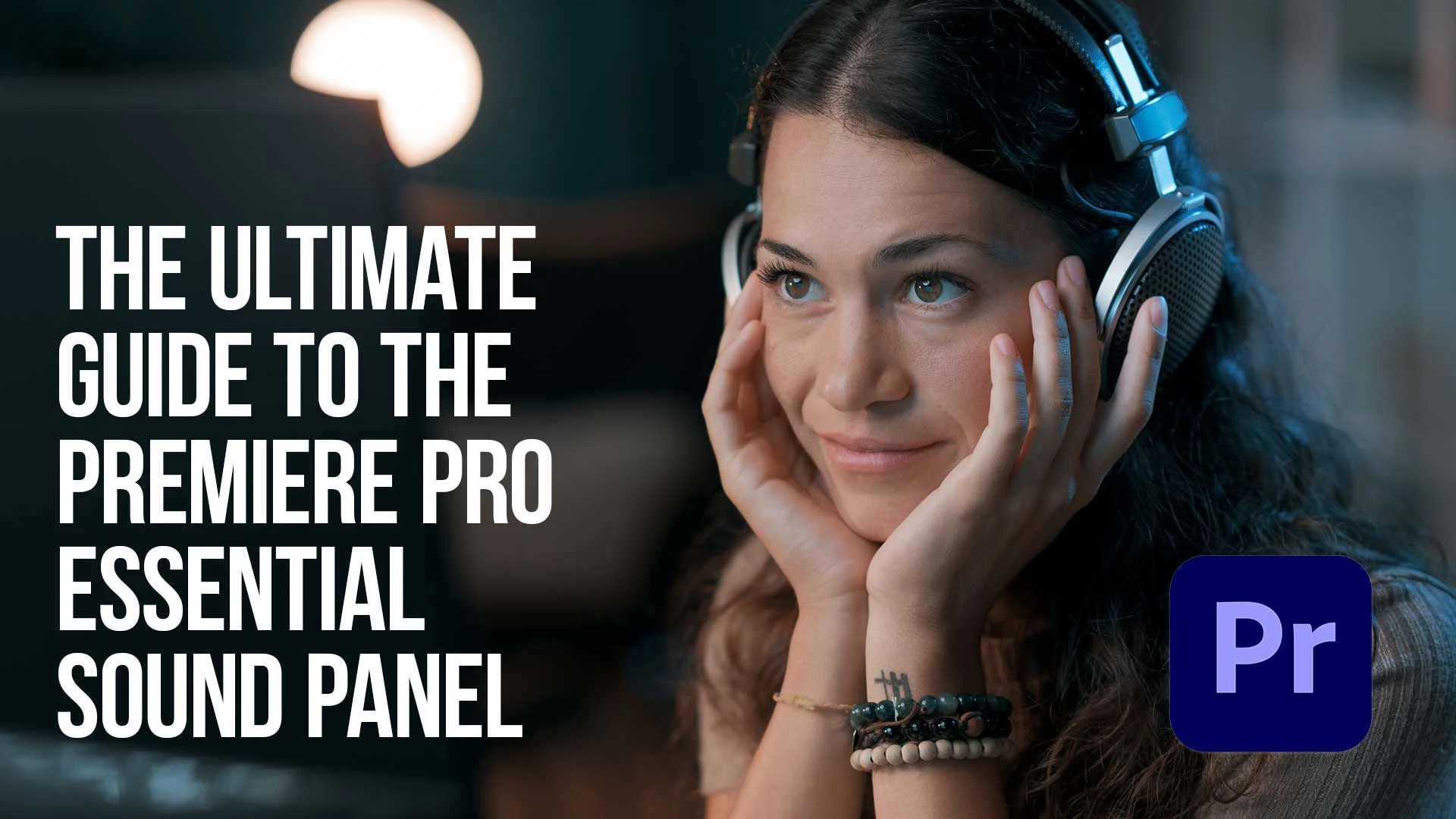They say an audience will forgive bad video quality but bad audio quality will make them turn off your video super fast.
Though no replacement for professional audio applications like Adobe Audition, Pro Tools, Logic Pro, etc., the Premiere Pro Essential Sound Panel gives you some great tools and simple controls to improve the quality of your sound.
Before you export your video from Premiere Pro, sweeten your sound!
Let’s take a deep dive into the panel and cover what every section does.
This page may include affiliate links.
Though I only recommend software that I use and fully believe in.
⭐⭐⭐⭐⭐
I pay for Adobe Creative Cloud and have used it every day in my 20-year career as a video editor, producer, and colorist.
Purchasing Adobe CC through these links will get you the best deal available and support this site.
Get Adobe Creative Cloud Now!
What is the Premiere Pro Essential Sound Panel?
Adobe Premiere Pro's Essential Sound Panel is a dynamic tool designed to simplify the audio post-production process for filmmakers and editors.
By categorizing audio into different roles such as dialogue, music, and effects, it provides intuitive controls to enhance the quality and clarity of soundtracks.
This feature streamlines the workflow, making audio editing accessible even for those who aren't audio professionals, while ensuring top-notch sound quality for your videos.
Essential Sound Panel Tutorial
Open up your latest Adobe Premiere Pro CC project, select some audio in the timeline, and open the Essential Sound panel (Window / Essential Sound) or for a dedicated audio workspace, Window / Workspaces / Audio.
Part of what makes the Essential Audio panel tick is choosing what "audio types" you have selected. If you haven’t selected anything yet, you’ll see four choices:
- Dialogue
- Music
- Sound Effects (SFX)
- Ambience
Select the appropriate tag for your audio (you can select multiple clips together, this is preferred) and the Essential Sound panel will give you the tools you need for that type of audio.
If you choose incorrectly, you can always click “Clear Audio Type” at the top of the panel.
Let’s start with a Dialogue track.
At the top are some Presets that vary from utilities (cleaning up noisy audio) to special effects (make the dialogue sound like a radio broadcast).
Let’s go through the sections of the Essential Sound Panel.
The Loudness Section
This will analyze the selected audio and make the loudness unified across all the selected clips.
After it’s done it will show you the target loudness it set everything to, such as -14 LUFS.
You can reset this at any time with the Reset Button.
What Does LUFS stand for?
LUFS is an acronym for "Loudness Units relative to Full Scale." It is a unit of measurement used to describe the loudness of audio signals.
The term was introduced by the European Broadcasting Union (EBU) in order to provide a consistent way of measuring and comparing the loudness of audio signals.
The full scale of the measure is determined by the maximum level of the digital audio signal, and the loudness is expressed as a negative value in dBFS (decibels relative to full scale).
For example, a loudness level of -23 LUFS would indicate that the audio signal is 23 dB below the maximum level of the digital audio signal.
The Repair Section
The Repair section allows you to fix common issues with dialogue, such as:
Reduce Noise This will reduce the level of noise in the background, such as ambience in the background (AC noise, etc) and clicks.
Reduce Rumble Rumble is low-frequency noise, generally below the 80 Hz range.
DeHum This type of noise is generally electrical in nature and centers around 60 Hz (electricity in North and South America) and 50 Hz (electricity in Europe, Asia, and Africa).
DeEss These are the sibilant sounds of the human voice like “S” and “T” sounds created by air movement between the mic and the subject
Reduce Reverb This setting will attenuate the “live” sound of a reverberant room, like an office with hard walls or a big room.
Pro Tip:
Any of these Noise Reduction techniques, when used aggressively, will result in degradation of the quality of the sound, so go gently.
The Clarity Section
This section improves the clarity of spoken words with a combination of compression (making the quiet parts louder and the louder parts quieter for a more uniform signal), and adjusting the frequency response of the recording, based on the relative pitch the speaker.
Dynamics Uses a compressor to adjust the dynamic range of the audio.
EQ reduces or boosts frequencies in the audio. You can choose from a list of presets that are either utility in nature or special effects. When you choose one, you’ll see a graphical representation of the EQ adjustment below. There is also an amount slider that controls the amount of the adjustment.
You can also more manually adjust the EQ off a clip by going to Effects / Audio Effects / Graphic Equalizer and make specific adjustments.
Enhance Speech Select whether the dialogue sounds High Tone or Low Tone to process the audio at specific frequencies.
Volume Finally, there’s a Level slider you can turn on and adjust the overall volume of the specific audio clip or selection of clips.
Creative This section allows you to add Reverb to an audio clip, with a drop-down menu to select preset reverb presets and an amount slider to control the level of the reverb effect.
Pro Tip:
You might only think of reverb as an effect added to singers, but included here are presets that can help you match ambience if you are matching multiple audio clips that need to sound like they were recorded in the same space, e.g. one clip recorded in a live room and another in a dead recording studio.
Also, you’ll get different presets depending on how your audio is tagged. For Example, audio tagged as Dialogue will have different room ambience presets, and audio tagged as SFX give you more indoor / outdoor settings specific to the needs of sound effects production.
Pan If what you have selected is a mono clip, you can choose to pan that clip to the Left or Right.

Music Clips in the Essential Sound Panel
If you’ve chosen audio clips tagged as Music, you get some different options.
Auto Ducking in Premiere Pro
This is an excellent feature that allows you to “Duck” your music (lower the volume) automatically when someone is talking.
Duck Against Allows you to choose what type of audio you are ducking against, generally this will be dialogue.
Sensitivity Allows you to adjust the threshold at which the ducking triggers. This will depend on the type of content you’re ducking against and I usually tweak this after the fact if my music is ducking too much or not enough.
Duck Amount controls how much the volume is reduced. I usually go with about 12 dB on this.
Fade Duration controls how quickly the volume adjustment happens when triggered.
Fade Position controls where you want the audio to fade in or out in relation to the dialogue.
Click Generate Keyframes and Premiere Pro will analyze everything and then generate volume keyframes on your timeline. You’ll need to click this again any time you move audio around or otherwise make audio edits on your timeline.
Premiere Pro Auto Ducking is a huge timesaver. I use it every day to control my background music against my voiceover in Premiere Pro.b
Some Pro Audio Tips for Adobe Premiere Pro Users
Use the new Remix tool
For me, the new Remix tool in Premiere Pro is a game-changer.
It allows you to grab the end of a music track and stretch it to a specific time you need to fit it to (the end of your edit, for example).
The Adobe Sensei AI engine will analyze the music and "remix it" by adding or subtracting sections (on the beat) and it will seamlessly fit to your edit.
The remix tool works best for content that has a specific tempo, like rock, hip hop or electronic.
I use this tool on pretty much every project and I've never had it do anything strange or make a bad decision about the length of the music.
Limit Your Mix
I always do my best to make sure I've got a limiter on the master track in the Audio Track Mixer.
Go to the mixer, twirl down the effect controls and add the limiter dynamics processing effect to the master track (Effects - Amplitude and Compression - Hard Limiter)
This is set to a hard limit of just below 0 dB (like -.1 dB) so I don't ever clip my audio.
Check Your LUFS
The recommended loudness level for YouTube content is -23 LUFS.
This level is considered to be the optimal loudness level for audio signals, as it allows the audio to be loud enough to be easily heard and understood, while also avoiding any potential issues with distortion or clipping.
Keep in mind that the loudness level of your audio may need to be adjusted depending on the specific content of your video and the preferences of your audience.
It's always a good idea to listen to your audio and adjust the loudness level as needed to ensure that it sounds clear and natural.
Don't Edit Audio in Video Frames
Have you ever been editing your audio on the Premiere Pro timeline and wished you had more resolution? Like nudging on frame was just too much?
There's a fix for that!
Right-Click on the title of the sequence and choose "Show Audio Time Units".
Then right-click on the Timecode and you can choose between Samples or Milliseconds. Any audio editing you do now on the timeline will be at this resolution, a much finer resolution than your video frame rate.
Premiere Pro Audio Frequently Asked Questions
Is Premiere Pro Good for Audio Editing?
Yes, Premiere Pro is an "ok" tool for audio editing.
It is a professional-grade video editing software that is widely used by filmmakers, television producers, and other media professionals.
Premiere Pro has a robust set of audio editing tools that can be used to edit, mix, and manipulate audio tracks for a wide range of purposes.
It is also integrated with other tools and services, such as Adobe Audition, that can be used to further enhance the audio quality of your videos.
In addition, Premiere Pro offers a variety of features and options that can help you fine-tune the audio in your videos, such as the ability to adjust the loudness, EQ, and other aspects of the audio to create a more polished and professional-sounding final product.
If you need to do any professional-level audio editing, you'd be better served by bouncing over to Adobe Audition or using a "pro tool" like Pro Tools or Logic Pro.
How do I import audio files into Premiere Pro?
To import audio files into Premiere Pro, simply click on the "File" menu and select "Import." This will open a window where you can browse your computer for the audio files you want to import. You can also drag and drop audio files directly into the Premiere Pro interface.
How do I edit the audio in my video clips?
To edit the audio in your video clips, first select the clip in the timeline and then use the audio tools in the "Essential Sound" panel to make adjustments. You can adjust the loudness, EQ, and other aspects of the audio to enhance its quality and make it more professional-sounding.
Can I use Premiere Pro to add music to my videos?
Yes, you can use Premiere Pro to add music to your videos. Simply import the music file into Premiere Pro and then drag it onto the timeline. You can adjust the volume and other settings to make it fit seamlessly with the rest of the audio in your video.
How do I remove background noise from my audio tracks?
To remove background noise from your audio tracks, first select the track in the timeline and then use the "Noise Reduction" effect in the "Effects" panel. This will open a window where you can adjust the settings to reduce the background noise. You can also use the "Equalizer" effect to fine-tune the audio and improve its overall quality.
Can I use Premiere Pro to create voiceovers for my videos?
Yes, you can use Premiere Pro to create voice-overs for your videos. Simply import your audio recording into Premiere Pro and then drag it onto the timeline. You can then adjust the volume, EQ, and other settings to make the voice-over sound clear and professional.
How do I adjust the volume of my audio tracks?
To adjust the volume of your audio tracks, first select the track in the timeline and then use the "Volume" control in the "Essential Sound" panel. You can drag the control up or down to increase or decrease the volume of the track. You can also use the "Normalize" option to automatically adjust the volume to a consistent level.
Can I use Premiere Pro to create a soundtrack for my video?
Yes, you can use Premiere Pro to create a soundtrack for your video. To do this, simply import the audio files you want to use and then drag them onto the timeline. You can then edit and mix the audio tracks to create a cohesive soundtrack that fits the mood and tone of your video.
Can I use Premiere Pro to record and edit audio?
Yes, you can use Premiere Pro to record and edit audio. To do this, simply click on the "Record Audio" button in the "Audio" panel and then follow the on-screen instructions to record your audio. You can then edit the audio using the tools in the "Essential Sound" panel to fine-tune the audio and make it sound professional.
How do I adjust the EQ of my audio tracks?
To adjust the EQ of your audio tracks, first select the track in the timeline and then use the "Equalizer" effect in the "Effects" panel. This will open a window where you can adjust the EQ settings to enhance the frequency spectrum of the audio. You can also use the "Noise Reduction" effect to remove any unwanted background noise.
Can I use Premiere Pro to add sound effects to my videos?
Yes, you can use Premiere Pro to add sound effects to your videos. Simply import the sound effect or effects you want to use and then drag them onto the timeline to begin editing.
You can then adjust the audio level, EQ, and other settings to make the sound effects fit seamlessly with the rest of the audio in your video.
You can also use the "Effects" panel to apply various audio effects to your sound effects, such as reverb, delay, and others, to create a more polished and professional-sounding final product.
Table of Contents
- What Is The Premiere Pro Essential Sound Panel?
- Essential Sound Panel Tutorial
- Sections Of The Essential Sound Panel.
- The Loudness Section
- The Repair Section
- The Clarity Section
- Music Clips In The Essential Sound Panel
- Some Pro Audio Tips For Adobe Premiere Pro Users
- Use The New Remix Tool
- Limit Your Mix
- Check Your LUFS
- Don'T Edit Audio In Video Frames
- Premiere Pro Audio FAQ
Video Editing Related Posts
Adobe Creative Cloud for Video Editing
Top 10 Video Editing Software for Mac
The Benefits of Dual-Monitor Setups for Video Editing
How to Choose the Right Video Editing Monitor for Your Needs
Best Monitors for Video Editing
Best Video Editing Software in 2023
Best Mac for Video Editing in 2023
(Almost) 50 Mistakes Every New Video Producer Makes
Breakthrough AI Tools: Elevate Your Video Production Game!
